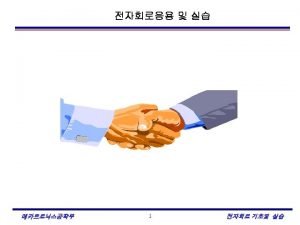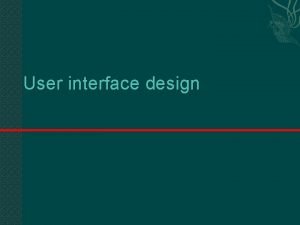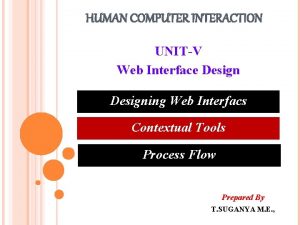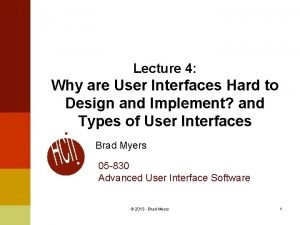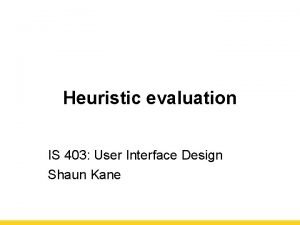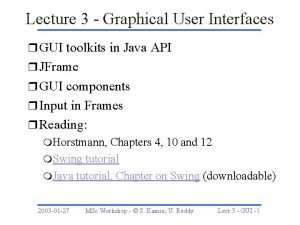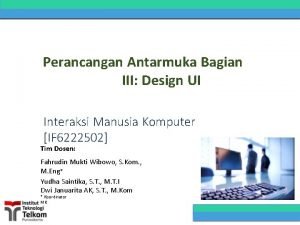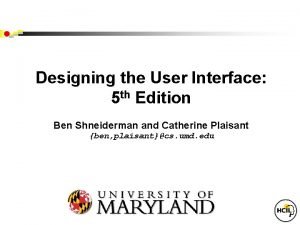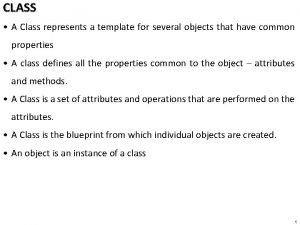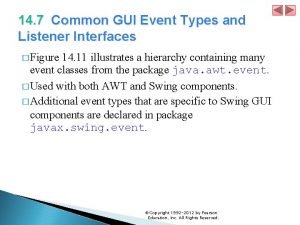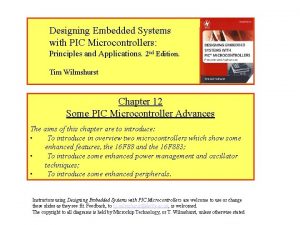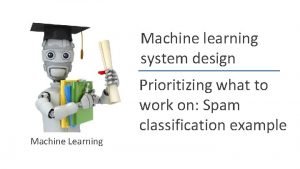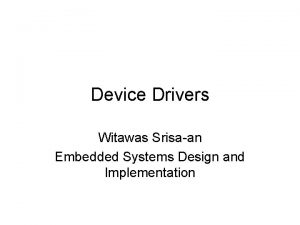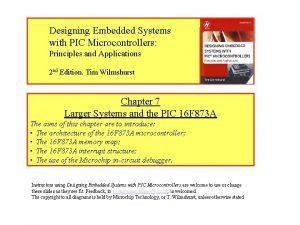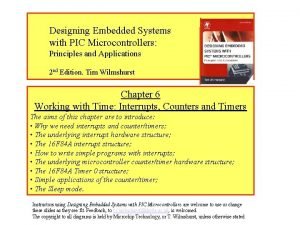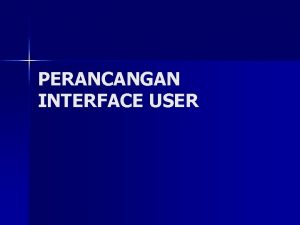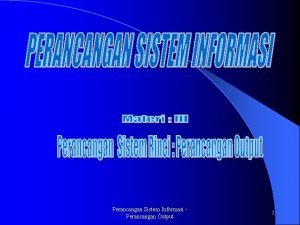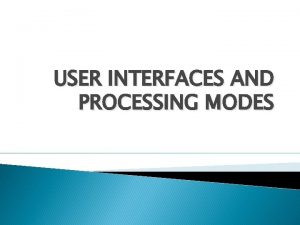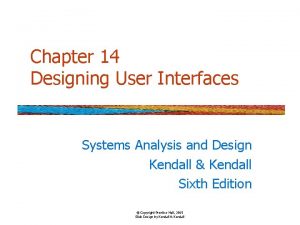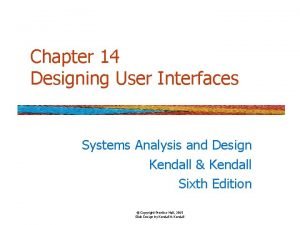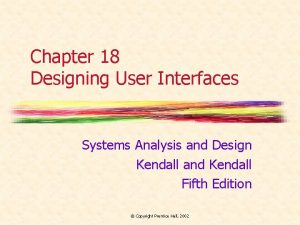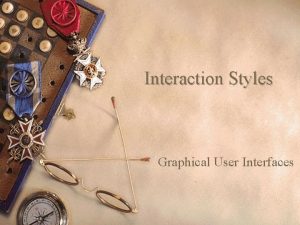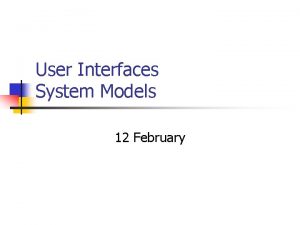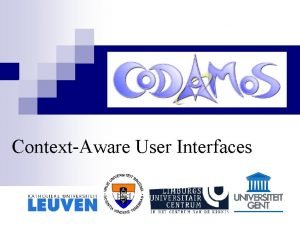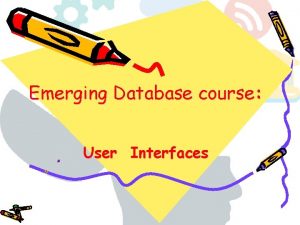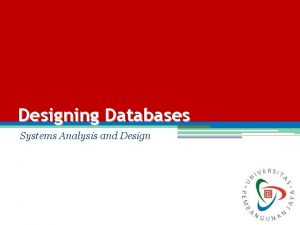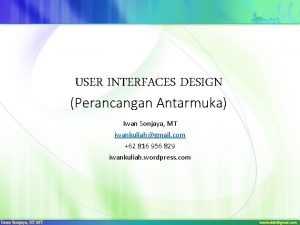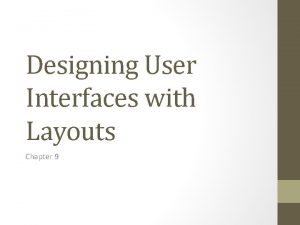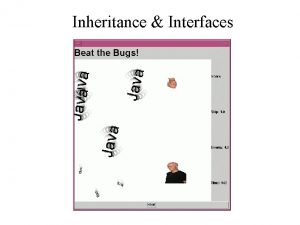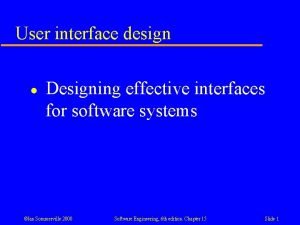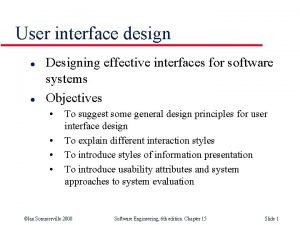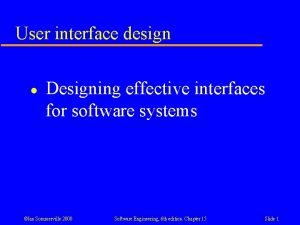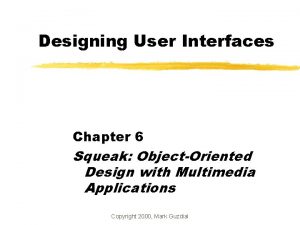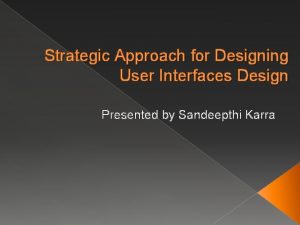Designing User Interfaces Systems Analysis and Design Perancangan











































- Slides: 43

Designing User Interfaces Systems Analysis and Design

Perancangan Basis Data Major Topics • • User interfaces Dialogue guidelines Feedback Help Ecommerce dialogue Data mining Ergonomics 14 -2

Perancangan Basis Data The User Interface The user interface is the system that helps users communicate with the computer system and/or the application system 14 -3

Perancangan Basis Data User Interface Design Objectives To design a better user interface, use the following objectives: ▫ Match the user interface to the task. ▫ Make the user interface efficient. ▫ Provide appropriate feedback to users. ▫ Generate usable queries. ▫ Improve productivity of knowledge workers. 14 -4

Perancangan Basis Data Components of the User Interface The user interface has two main components: ▫ Presentation language, which is the computer-to-human part of the transaction. ▫ Action language that characterizes the human-to-computer portion. 14 -5

Perancangan Basis Data Types of User Interfaces There are several types of user interfaces: ▫ Natural-language interfaces. ▫ Question-and-answer interfaces. ▫ A menu interface. ▫ Form-fill interfaces. ▫ Command-language interfaces. ▫ Graphical User Interfaces (GUIs). 14 -6

Perancangan Basis Data Natural-Language Interfaces Natural-language interfaces permit users to interact with the computer in their everyday or "natural" language. 14 -7

Perancangan Basis Data Question-and-Answer Interfaces ▫ The computer displays a question for the user on the screen. ▫ The user enters an answer via the keyboard or a mouse click. ▫ The computer acts on that input information in a preprogrammed manner. ▫ New users may find the question-and-answer interface most comfortable. 14 -8

Perancangan Basis Data A Menu Interface • A menu interface, that provides the user with an onscreen list of available selections. • A nested menu is a menu that can be reached through another menu. 14 -9

Perancangan Basis Data Advantages of Nested Menus The advantages of nested menus are: ▫ Less cluttered screen. ▫ Eliminate menu options which do not interest a user. ▫ Allow users to move quickly through the program. 14 -10

Perancangan Basis Data Graphical User Interface (GUI) Menus GUI menus guidelines: ▫ The main menu is always on the screen. ▫ The main menu uses single words. ▫ The main menu should have secondary menus grouped into similar features. 14 -11

Perancangan Basis Data Graphical User Interface (GUI) Menus GUI menus guidelines (continued): ▫ The secondary drop-down menus often consist of more than one word. ▫ Secondary options perform actions or display additional menu options. ▫ Menu items in grey are unavailable for the current activity. 14 -12

Perancangan Basis Data Form-Fill Interfaces • Form-fill interfaces are onscreen forms displaying fields containing data items or parameters that need to be communicated to the user. • Form-fill interfaces may be implemented using the Web. 14 -13

Perancangan Basis Data Advantages and Disadvantages of Web Forms • Advantages of using a Web-based form are: ▫ User enters the data. ▫ Data may be entered 24 hours a day, globally. • Disadvantages of a Web-based form are: ▫ The experienced user may become impatient with input/output forms. 14 -14

Perancangan Basis Data Command-Language Interfaces • Allow the user to control the application with a series of keystrokes, commands, phrases, or some sequence of these. • Require memorization of syntax rules. • May be an obstacle for inexperienced users. 14 -15

Perancangan Basis Data Graphical User Interfaces (GUIs) Allow direct manipulation of the graphical representation on the screen. ▫ Can be accomplished with keyboard input, joystick, or mouse. ▫ Requires more system sophistication than other interfaces. 14 -16

Perancangan Basis Data Voice or Speech Recognition • Voice or speech recognition systems are developing rapidly • There are two different types of voice recognition: ▫ Continuous speech systems, allowing for dictation. ▫ Speaker independence, so people can enter commands or words at a given workstation. 14 -17

Perancangan Basis Data Evaluating User Interfaces The five useful standards in evaluating the interfaces are: ▫ The training period for users should be acceptably short. ▫ Users early in their training should be able to enter commands without thinking about them, or referring to a help menu or manual. 14 -18

Perancangan Basis Data Evaluating User Interfaces The five useful standards in evaluating the interfaces are (continued): ▫ The interface should be seamless so that errors are few, and those that do occur are not occurring because of poor design. ▫ Time necessary for users and the system to bounce back from errors should be short. ▫ Infrequent users should be able to relearn the system quickly. 14 -19

Perancangan Basis Data Dialog • Dialog is the communication between a person and the computer • Three key points to be considered are: ▫ Meaningful communication. ▫ Minimal user action. ▫ Standard operation and consistency. 14 -20

Perancangan Basis Data Communication • Communication means that the user understands the information that is being presented • Users with less skill require a greater amount of communication • Provide easy to use help screens • Often these contain hyperlinks to other related help topics 14 -21

Perancangan Basis Data Minimal User Action Minimal user action is achieved by: ▫ Entering codes instead of code meanings. ▫ Enter only data that are not stored on files. ▫ Not requiring users to enter editing characters. ▫ Supplying default values on entry screens. ▫ Providing inquiry, change, or delete programs with short entry fields. 14 -22

Perancangan Basis Data Minimal User Action Minimal user action is achieved by: • Providing keystrokes for selecting menu options that are normally selected using a mouse • Selecting codes from a pull-down menu on a GUI screen 14 -23

Perancangan Basis Data Standard Operation Standard operation is achieved by: ▫ Keeping header and footer information in the same locations for all screens. ▫ Using the same keystrokes to exit a program. ▫ Using the same keystroke to cancel a transaction. ▫ Using a standard key for obtaining help. 14 -24

Perancangan Basis Data Standard Operation • Standard operation is achieved by (continued): ▫ Standardized use of icons when using graphical user interface screens. ▫ Consistent use of terminology within a screen or Web site. ▫ Providing a consistent way to navigate through the dialog. ▫ Consistent font alignment, size, and color on a Web page. 14 -25

Perancangan Basis Data Tab Control Dialogue Boxes • Tab control dialog boxes are a feature of GUI design. • They should have logically grouped functions on each tab. • Each tab dialog box should have OK, Cancel or Apply, and perhaps Help buttons. 14 -26

Perancangan Basis Data Feedback All systems require feedback in order to monitor and change behavior by: ▫ Comparing current behavior with predetermined goals. ▫ Giving back information describing the gap between actual and intended performance. 14 -27

Perancangan Basis Data Types of Feedback to the user is necessary in seven distinct situations: ▫ ▫ ▫ ▫ The computer has accepted the input. The input is in the correct form. The input is not in the correct form. There will be a delay in processing. The request has been completed. The computer cannot complete the request. More detailed feedback is available. 14 -28

Perancangan Basis Data Program Help Program help comes in a variety of ways: ▫ Pressing a function key, such as F 1. ▫ A GUI pull-down menu. ▫ Context-sensitive help, specific for the operation being performed. ▫ Iconic help, obtained when a cursor is left over an icon for a few seconds. 14 -29

Perancangan Basis Data Program Help Program help comes in a variety of ways (continued): • Wizards, which provide a series of questions and answers when trying to perform an operation • Telephone help desks provided by the software manufacturer • Software forums on nation wide bulletin boards 14 -30

Perancangan Basis Data Ecommerce Dialog • Extra considerations are needed when developing ecommerce Web sites. • Feedback needs to be solicited from customers, using either of two methods: ▫ Launch the user’s email program. ▫ Create a blank feedback template with a submit button labeled “feedback”. 14 -31

Perancangan Basis Data Intuitive Navigation for Ecommerce Sites Intuitive navigation should be designed for: ▫ Creating a rollover menu. ▫ Building a collection of hierarchical links. ▫ Placing a site map on the home page and emphasizing the link to it from every page on the site. ▫ Placing a navigational bar on every inside page that repeats the categories used on the entry screen. 14 -32

Perancangan Basis Data Types of Queries • The six different types of queries are : ▫ Obtain specified data for a particular entity. ▫ Find a group of entities that have certain characteristics. ▫ Find attributes for an entity for certain characteristics. ▫ Display all the attributes for a certain entity. 14 -33

Perancangan Basis Data Types of Queries The different types of queries are (continued): ▫ Find all entities with a certain characteristic. ▫ List attributes for all entities for certain characteristics. 14 -34

Perancangan Basis Data Entities, Attributes, and Values 14 -35

Perancangan Basis Data Query Notation V is value, E is entity, A is attributes, variables in parentheses are given: ▫ Query type 1: V <--- (E, A) ▫ Query type 2: E <--- (V, A) ▫ Query type 3: A <--- (V, E) ▫ Query type 4: V <--- (E, all A) ▫ Query type 5: E <--- (V, all A) ▫ Query type 6: A <--- (V, all E) 14 -36

Perancangan Basis Data Methods for Implementing Queries There are two methods for implementing database queries: ▫ Query By Example (QBE), which allows users to select fields and specify conditions using a grid. ▫ Structured Query Language (SQL), which uses a series of keywords and commands to select the rows and columns that should be displayed. 14 -37

Perancangan Basis Data SQL Example 14 -38

Perancangan Basis Data Parameter Queries A parameter query allows users to enter a value to select records without changing the query syntax. 14 -39

Perancangan Basis Data Web Searches • Web searches uses search engines to answer a query. • Guidelines for searching the Web are: ▫ Decide whether to search or surf the Web. ▫ Think of the key terms before searching. ▫ Construct the search questions logically, with attention to the use of AND and OR search logic. 14 -40

Perancangan Basis Data Web Searches Guidelines for searching the Web are (continued): ▫ Use a metasearch engine that saves your searches ▫ Use a search engine that informs you of changes in the Web sites you select ▫ Look for new search engines periodically 14 -41

Perancangan Basis Data Mining • Data mining is gathering a large amount of information about a person and their habits and using that information as a predictor of future behavior. • It must be carefully and ethically used to avoid infringing on an individual’s privacy. 14 -42

Perancangan Basis Data Mining 14 -43
 User interfaces design dc
User interfaces design dc Interface and dialogue design
Interface and dialogue design Which is not an objective of designing interfaces?
Which is not an objective of designing interfaces? Unitv web
Unitv web Characteristics of web interface
Characteristics of web interface Why are user interfaces hard to implement
Why are user interfaces hard to implement Gulf of execution and evaluation
Gulf of execution and evaluation Java gui for r
Java gui for r User interface design in system analysis and design
User interface design in system analysis and design Input output and form design
Input output and form design Communication interfaces in embedded systems
Communication interfaces in embedded systems Perancangan antarmuka adalah
Perancangan antarmuka adalah Dialog dalam konteks perancangan user interface adalah
Dialog dalam konteks perancangan user interface adalah Ben shneiderman designing the user interface
Ben shneiderman designing the user interface User interface analysis and design
User interface analysis and design Single user and multiple user operating system
Single user and multiple user operating system Single user and multi user operating system
Single user and multi user operating system Seven phases of the systems development life cycle
Seven phases of the systems development life cycle What is difference between abstract class and interface
What is difference between abstract class and interface What is difference between abstract class and interface
What is difference between abstract class and interface Gui event types in java
Gui event types in java Examples of colloids
Examples of colloids Designing embedded systems with pic microcontrollers
Designing embedded systems with pic microcontrollers Designing machine learning systems
Designing machine learning systems Designing device drivers for embedded systems
Designing device drivers for embedded systems Designing embedded systems with pic microcontrollers
Designing embedded systems with pic microcontrollers Designing embedded systems with pic microcontrollers
Designing embedded systems with pic microcontrollers Systems analysis and design in an age of options
Systems analysis and design in an age of options System analysis
System analysis Systems analysis and design in a changing world
Systems analysis and design in a changing world Systems analysis and design in a changing world
Systems analysis and design in a changing world System analysis and design alan dennis
System analysis and design alan dennis Sad system analysis and design
Sad system analysis and design Structured systems analysis and design method
Structured systems analysis and design method Systems analysis and design 5th edition
Systems analysis and design 5th edition Modern systems analysis and design
Modern systems analysis and design Kendall & kendall systems analysis and design
Kendall & kendall systems analysis and design System analysis and design dennis
System analysis and design dennis Systems analysis and design alan dennis
Systems analysis and design alan dennis Systems analysis and design alan dennis
Systems analysis and design alan dennis Systems analysis and design alan dennis
Systems analysis and design alan dennis Systems analysis and design alan dennis
Systems analysis and design alan dennis Systems analysis and design alan dennis
Systems analysis and design alan dennis Systems analysis and design alan dennis
Systems analysis and design alan dennis
